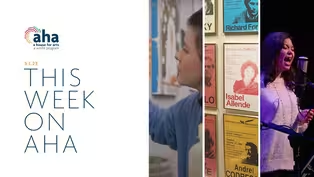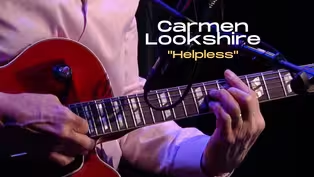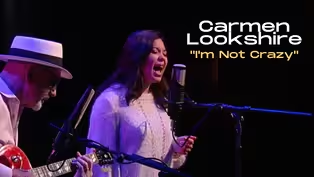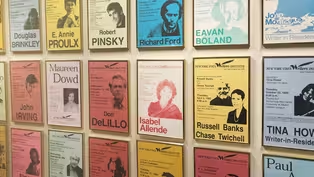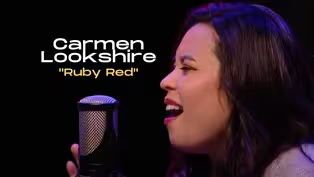
Blending Cultures: Arnela Mahmutović's Journey
Clip: Season 8 Episode 20 | 6m 21sVideo has Closed Captions
Arnela Mahmutović explores her dual identity as a first-generation Bosniak American.
Arnela Mahmutović, a first-generation Bosniak American, navigates the complexities of her dual identity in her artwork. Her pieces showcase the blending of her traditional upbringing with the values of Western society. Join us as we visit her studio in Albany, NY, and discover the inspiration behind her unique pieces.
Problems playing video? | Closed Captioning Feedback
Problems playing video? | Closed Captioning Feedback
AHA! A House for Arts is a local public television program presented by WMHT
Support provided by the New York State Council on the Arts (NYSCA), M&T Bank, the Leo Cox Beach Philanthropic Foundation, and is also provided by contributors to the WMHT Venture...

Blending Cultures: Arnela Mahmutović's Journey
Clip: Season 8 Episode 20 | 6m 21sVideo has Closed Captions
Arnela Mahmutović, a first-generation Bosniak American, navigates the complexities of her dual identity in her artwork. Her pieces showcase the blending of her traditional upbringing with the values of Western society. Join us as we visit her studio in Albany, NY, and discover the inspiration behind her unique pieces.
Problems playing video? | Closed Captioning Feedback
How to Watch AHA! A House for Arts
AHA! A House for Arts is available to stream on pbs.org and the free PBS App, available on iPhone, Apple TV, Android TV, Android smartphones, Amazon Fire TV, Amazon Fire Tablet, Roku, Samsung Smart TV, and Vizio.
Providing Support for PBS.org
Learn Moreabout PBS online sponsorship- I'm in Albany, New York to visit with artist Arnela Mahmutovic.
Let's go.
(bright music) - I'm a first-generation Bosniak American and my family came over about 23 years ago from Eastern Europe, specifically from a region called Sandzak, which borders a few countries.
We essentially fled because that area and that region was not safe anymore.
I spent most of my life kind of balancing these two parts of myself, and there's a lot of responsibility, I think, as a child of immigrants to, on one hand, preserve this culture and tradition that your parents carry, and on the other end you are trying to assimilate and adapt to the world that's around you.
And that definitely finds its way into the work this dual identity.
I'm trying to compare and contrast these two sides of myself.
(traditional music) So I see my paintings as these products of a disjointed history.
So most of them are compiled with multiple different elements that I source from a variety of places.
And sometimes, that can just be material alone.
So I can try to pair something very, very traditional and old like oil painting alongside a newer medium or maybe a new technique or approach.
I also incorporate drawing a lot into my practice, and there's this contrast between the soft and slow act of painting with this very fast, rigorous, and sort of agitated nature of drawing.
(pensive music) And then, on the other end, there's this imagery that I tried to pair to ultimately create some type of harmony, but most of the time it doesn't work because the images weren't found together and maybe aren't supposed to exist together.
And some of that imagery is specifically pulled from eastern miniature painting, Islamic manuscripts.
So you'll find borders, pattern, this sort of collapsing of perspective, alongside a very rendered and molded figure that maybe aligns more closely to Western rules and ideals within painting.
(pensive music) Figure or figuration in my paintings is, I think, the core of it all.
And I, of course, have fun thinking about pattern, and color, and composition, but without figure, I don't think I would enjoy painting as much as I do.
For me, the body is the closest and most immediate way to translate a story.
So no matter what the figure is, we immediately feel some type of closeness to it.
Maybe the figure connect as a vessel for someone else to maybe place themselves in that environment.
There's always this veiling that encapsulates them, and that veiling has a few different references.
One is a more religious reference, and the other is that it acts as this anonymous barrier where you can't place the figures in a specific time.
I like the fact that they feel like maybe they were created 100 years ago, or yesterday, or at some point in the future.
For a while, I really didn't know how to identify, and I was really rejecting this traditional aspect of my life and really the Bosniak part of myself because it didn't fit in anywhere.
I mean, I ate different food, I had this other language I had to speak.
There were rules and sort of regulations that my parents had in place, right, to sort of maintain some type of order for them, right?
And it took a long time for me to make peace with the thought of them existing or coexisting with one another, and that really didn't happen until I found art and making as a way to deal with a lot of those difficulties.
A recent piece that I'm working on centers food and the importance of food in, I think, many cultures, but specifically Bosniak American households and how it acts as this connecting factor and a means for preservation.
So when we think about families that were displaced or finding themselves in a new environment, food is a way to sort of transport them to something familiar and to pass it down.
I think a lot of parents who move to another country have very, very high expectations of what their children will end up doing.
So they kind of ideally would like for us to go into a medical field, maybe something that has money on the other side of it.
And my parents were very skeptical at the beginning, but as soon as I started going to college, I think they noticed a shift or a change in me where it went from this frustrated teenager who was rebelling and, I don't know, talking back, to a more level-headed person who found a goal, right?
They found the structure in painting, in learning.
And I think that that spark in me is what helped them understand that this was important.
I mean, and now, it's just a part of my life.
I think they are completely accepting.
And maybe they don't understand everything.
I don't think they get most of the paintings.
That's totally fine.
But I think they know that I have a deep, deep connection and love for the culture that I'm trying to get across somehow.
And that means a lot to them.
To be making images and art that can resonate with someone else who's either gone through the same journey that I have, or maybe is parallel to my journey, or is experiencing something similar.
That's incredibly beautiful, and it's a privilege to be able to experience that through making.
(gentle music)
Video has Closed Captions
Preview: S8 Ep20 | 30s | Enjoy a rich exploration of cultural identity through art, literature, and music. (30s)
'Helpless' by Carmen Lookshire & Joseph Carrick
Video has Closed Captions
Clip: S8 Ep20 | 2m 37s | Join us for an intimate performance of 'Helpless' by Carmen Lookshire and Joseph Carrick. (2m 37s)
'I'm Not Crazy' by Carmen Lookshire & Joseph Carrick
Video has Closed Captions
Clip: S8 Ep20 | 2m 25s | An intimate performance of 'I'm Not Crazy' by Carmen Lookshire and Joseph Carrick. (2m 25s)
Inside the New York State Writers Institute w/ Paul Grondahl
Video has Closed Captions
Clip: S8 Ep20 | 11m 10s | Discover the history and impact of the NYS Writers Institute with Paul Grondahl on AHA. (11m 10s)
'Ruby Red' by Carmen Lookshire & Joseph Carrick
Video has Closed Captions
Clip: S8 Ep20 | 2m 32s | Join us for an intimate performance of 'Ruby Red' by Carmen Lookshire and Joseph Carrick. (2m 32s)
Providing Support for PBS.org
Learn Moreabout PBS online sponsorshipSupport for PBS provided by:
AHA! A House for Arts is a local public television program presented by WMHT
Support provided by the New York State Council on the Arts (NYSCA), M&T Bank, the Leo Cox Beach Philanthropic Foundation, and is also provided by contributors to the WMHT Venture...
